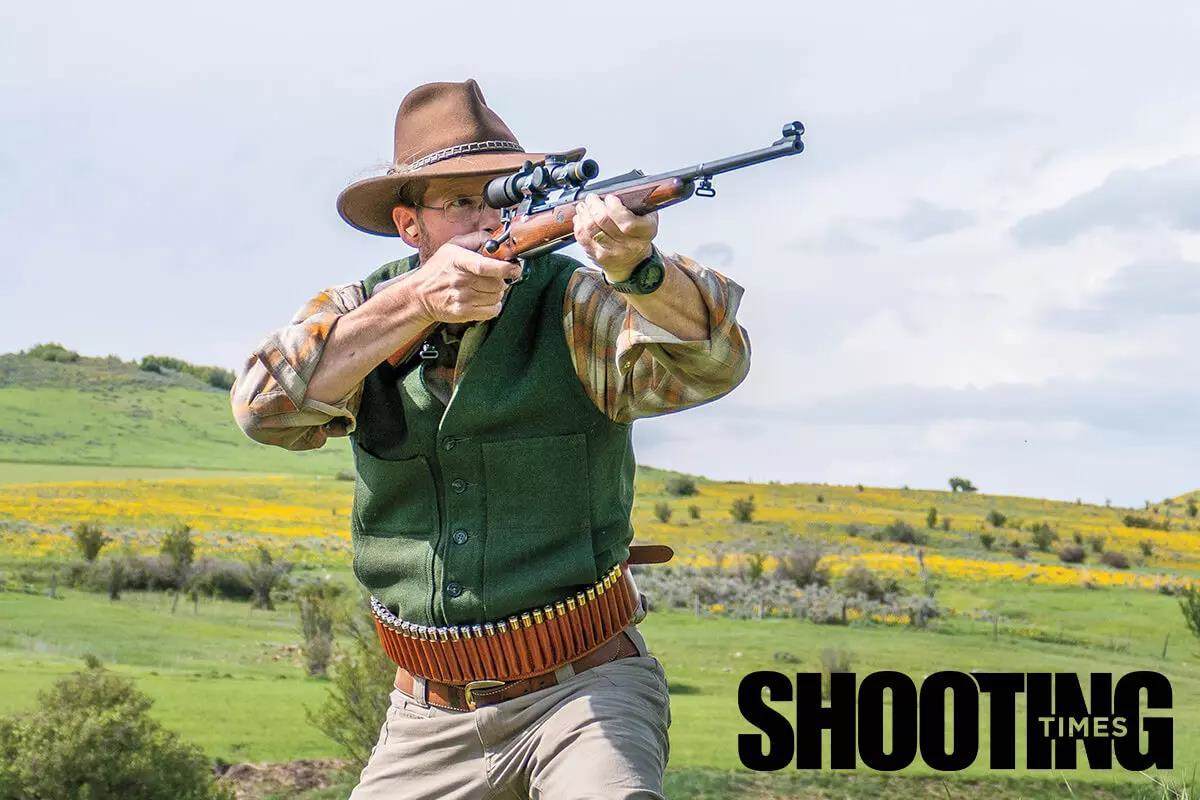
With a few touches from a custom gunsmith, this Dumoulin Mauser 98 makes a lively and compact dangerous-game rifle.
Although Germany maintained control of Mauser-based military rifle manufacturing until the end of World War II, Belgium was arguably the most prominent manufacturer of Mauser-type sporting rifles for a century or more. From the early Dumoulin rifles of 100 years ago to the Mausers made for United States companies (from Weatherby and Browning right down to J.C. Higgins), the gunmakers of Belgium were a powerful, influential force. The rifle shown throughout this report was made in Herstal, Belgium, by Dumoulin. There was an entire family of gunmakers named Dumoulin, and they lived and worked in various regions. Most were in the Liège area of Belgium.

The history of the Dumoulin gunmakers is cloudy and difficult to pin down. Most likely, they were in business in the early 1800s and rose to prominence in the late 1800s, producing excellent dangerous-game “magazine” rifles using Mauser 98-type actions. By the 1950s, Henri Dumoulin and his sons Ernest and Noel had become famous. Various branches of the family were affiliated but not necessarily the same company. Guns are variously marked E. Dumoulin, Liège; Dumoulin S.A. Herstal, Belgium; and probably other variations. However, all rifles marked Dumoulin have a reputation for being superb firearms. Eventually, Henri sold his company to a Mr. Aukes, who continued overseeing manufacturing under the name of Henri Dumoulin & Fils. I’ve found marketing information online for as late as 2017, but I cannot find any current website or literature on an active Dumoulin brand, sad to say. I first became intrigued with the brand upon reading Kevin “Daktari” Robertson’s writings on dangerous-game rifles. Robertson is an African PH and veterinarian of some renown, and he has rather stout opinions on what constitutes a proper dangerous-game rifle. His own go-to was a Dumoulin chambered for the massive, authoritative .505 Gibbs cartridge.
I figured if a Dumoulin was good enough to be Daktari’s primary dangerous-game rifle, it would certainly be good enough for me. And what I really wanted was a nice Mauser-based rifle in 9.3×62. While I was searching Gunbroker, a Dumoulin in 9.3×62 appeared, built on a square-bridge Mauser 98-type sporting action. I nearly got sweaty palms. The photos showed a gun that was well-used, with some nonoriginal work—gun-plumber-looking unusable scope bases, and bluing wear. That didn’t put me off; rather, it made the rifle potentially affordable on my budget. I put in a bid. Days later, I had won the Dumoulin! And when it arrived, it was apparent that the rifle had the visible issues I’d seen, plus a few more. It didn’t feed reliably. The nonoriginal screw holes drilled into the tops of the square-bridge receiver rings were crooked. Some enterprising soul had blued the hardened bolt (which originally was surely finished in the white), and the steel had turned a plum color. On the plus side, the rifle felt right at home in my hands and at my shoulder. It’s not a fancy Dumoulin; it’s stocked in sensible, dense, straight-grain walnut. However, it has lovely lines, a unique quarter-rib with a deep V express-type rear sight built in, and that wonderful square-bridge Mauser 98 sporting action.
Mauser’s Genius
Paul von Mauser’s M98 is a turnbolt action fed by an internal, top-loaded box magazine. Introduced in 1898, the M98 influenced bolt-action design around the world. Although it’s a century and a quarter old, the M98 and its derivatives are still the most popular of all actions for dangerous-game rifles. Mauser 98 bolts feature dual locking lugs up front and the feature that made it famous—a full-length, nonrotating claw extractor that captures the base of each cartridge as it emerges from the magazine and controls it through the chambering, firing, extracting, and ejecting processes. The Mauser 98 was the fundamental controlled-feed action renowned for reliability. Another excellent feature is the wing-type, three-position safety on the bolt shroud. When engaged, it blocks the firing pin from movement and is as fail-safe a design as has ever been invented.
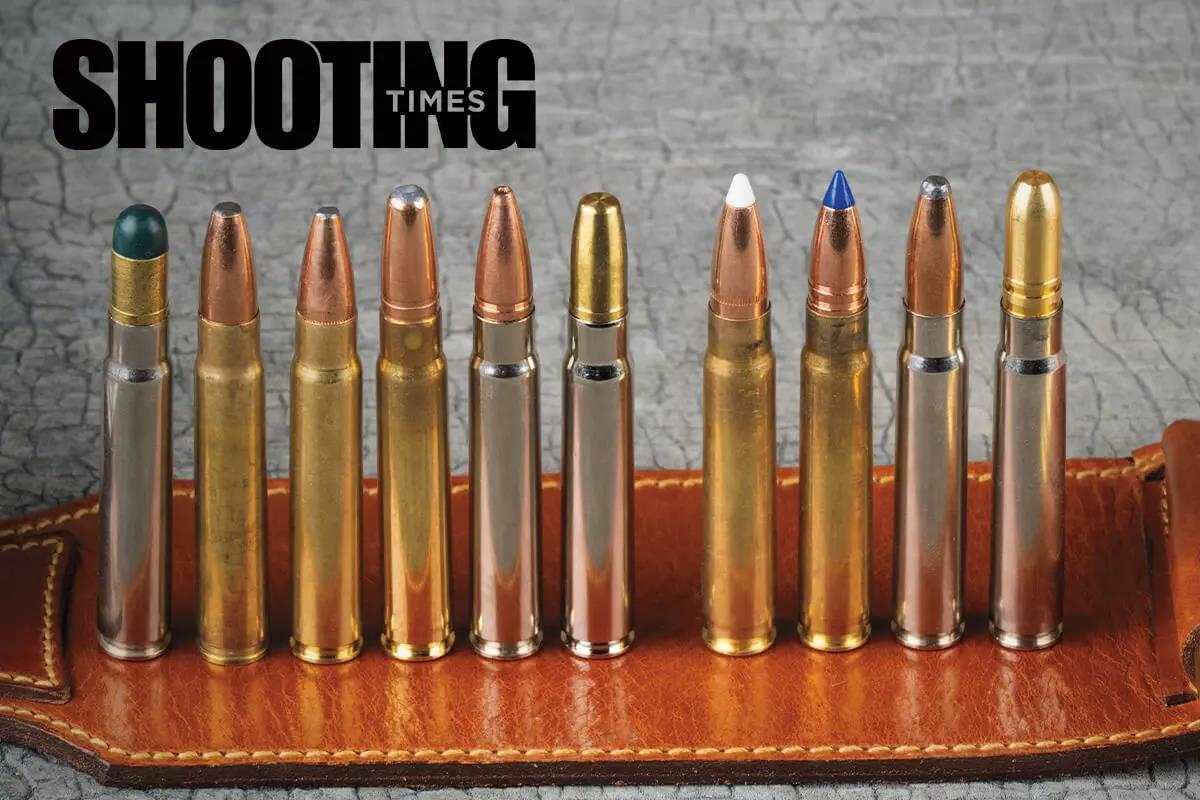
It’s worth noting that there were several other Mauser bolt-action designs leading up to the M98, including the relatively popular 1896 “Swedish” small-ring Mauser, but the M98 was the culmination of perfection. Over the several decades following the 1898 introduction of the M98, nations around the world plagiarized the design. Ironically, the U.S. paid royalties to Mauser & Co. for patent infringements incorporated into America’s excellent M1903 Springfield action while our rifle was battling it out against their original M98 in the trenches of World War I. Mauser 98s weren’t just for soldiers. Makers of sporting arms around the world adopted the Mauser design. They ranged from Great Britain’s Royal Gunmakers to myriad small Germanic makers. Most simply modified the outstanding German-made military M98s. (One can tell a military Mauser action by the thumb cutout in the left receiver wall, which was engineered to enable soldiers to press home a fresh stripper clip of cartridges.)
The M98 action proved adaptable to a vast spectrum of cartridges. Although a tad short for lengthy rounds, such as the .375 H&H Magnum, skillful gunsmithing could modify an M98 to suit. Even more impressively, proper big-bore cartridges, such as the .404 Jeffery, could be shoehorned in, and they provided dangerous-game hunters in Africa with elephant-walloping authority in a simple, reliable, accurate, magazine-fed repeating rifle. More commonly, hunting rifles in 6.5×55, 7×57, 9.3×62, and the like were built, and they required no adaptation for cartridge length and diameter. Belgium, where the Mauser brothers honed their craft and found inspiration to invent, emerged as a dominant force in the world of sporting Mausers. True sporting Mauser actions are visually distinguishable by the complete left-side receiver wall—no thumb cutout is present. Another feature emerged as the crème de la crème of fine sporting Mausers: the double-square-bridge action. Originally engineered to pair with German claw-type quick-detach scope rings, square-bridge actions have a distinctive look and are much sought after by Mauser collectors. Currently, the best modern-made Mauser-type actions still feature square bridges.
Improvements
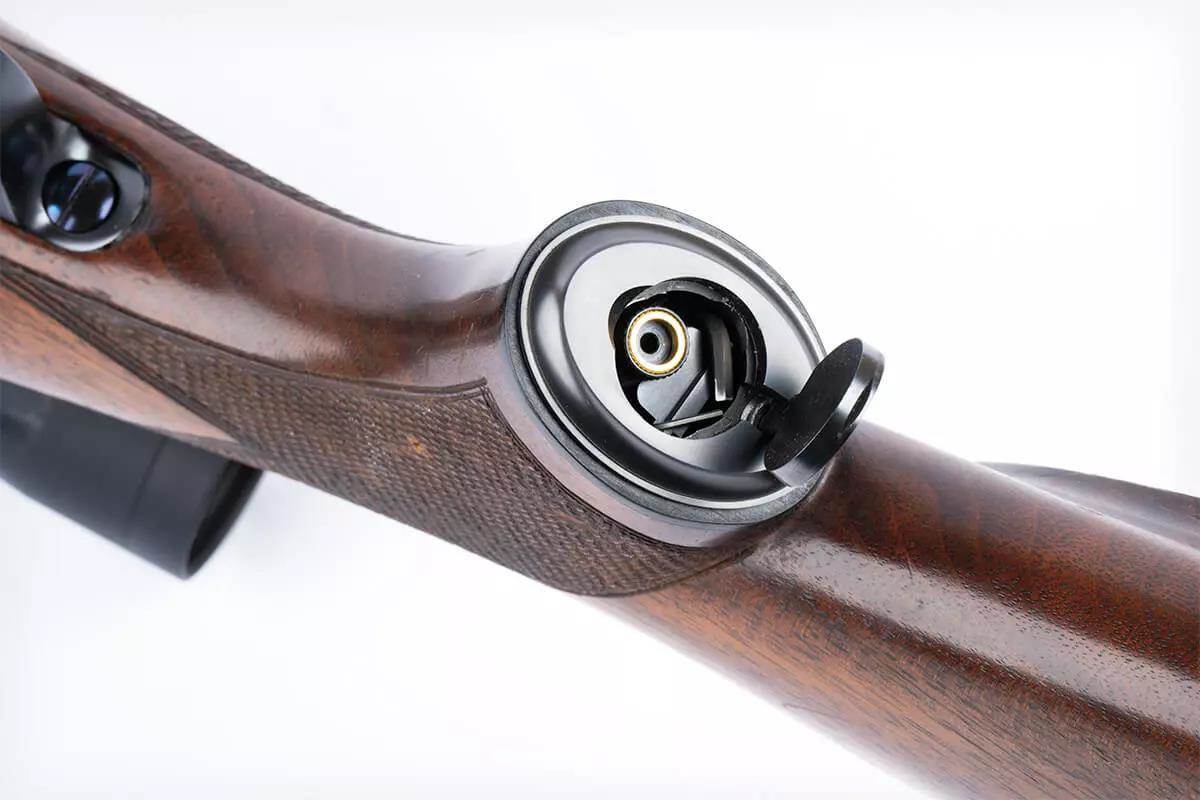
German claw-type quick-detach scope rings popular at the time were not standardized and generally were hand-fitted. Many square-bridge Mauser actions were sold without being milled for rings. My Dumoulin is one such. At some point, an enterprising soul drilled and tapped both receiver rings for a set of awkwardly large scope bases, which he mounted crooked and shimmed to equal height. The result was a bit of a travesty, ruining the lines and fine looks of the old Mauser and occluding the rear sight. Plus, there was the unattractive bronzy-plum color of the poorly blued bolt. In addition, honest wear on the stock and at the carry points on the bottom metal suggested the rifle was not a safe queen. As for the reliability issues, the follower and follower spring seemed wonky. I suspect the originals may have become lost at some point and were replaced with random parts.
After stewing on the situation for a few days, I sent a message to my friend Joe Smithson, along with a few photos of the receiver bridges. Joe and his son Brett are the finest artisan-quality gunsmiths I’ve ever met, and they do exclusive work like building bespoke Mauser-based custom rifles and restoring vintage Holland & Holland rifles for Mauser savants. Brett asked me to measure the flat atop the square receiver bridges and shortly came back with a message. “Our quick-detach rings will fit. Send us the rifle!” Smithson’s rings are used by Rigby and other top-grade riflemakers around the world. It was a perfect solution. Off the rifle went, along with a note asking Joe and Brett to look into the feeding issues, as well.
Several weeks later the rifle came back to me. To my surprise and delight, Brett had not only machined the square-bridge receiver for Smithson rings and fitted a new follower and spring that solved the feeding issues, but he’d also performed a complete restoration on the metal parts of the rifle—and not just any restoration. He’d raised the Dumoulin rifle like a phoenix from the ashes; it was more beautiful than it had ever been. Barrel, action, bottom metal, grip cap, and bolt shroud were all rust blued a lustrous, midnight-deep blue. The bolt was polished bright, and the full-length claw extractor was finished in a mirror-clear “fire” nitre blue, as were the Oberndorf floorplate latch, the bolt release, and all screw heads and pins.
Brett’s incredible craftsmanship is apparent everywhere on the rifle. The original maker rollmarks on the barrel and the caliber designation and proof marks on the barrel and action are all crisp and clean, without the slightest sign of the rounding that usually accompanies rebluing. In the grip cap, Brett had fitted an elegant, lightly domed round trapdoor. Inside it were a peep sight that fits into the rear receiver bridge and a filler plate for the front receiver bridge. I’d sent a Leupold VX-3HD 1.5-5X 20mm scope for the rifle, and Brett had mounted it and sighted it in. I won’t go into detail on the superlative quality and function of the ring system here, but I highly recommend readers visit the company’s website (smithson-gunmaker.com).
Rangetime
With a stack of factory ammo and several handloads, I repaired to the range. At the bench, I grasped the fore-end and pistol grip firmly, rested the back of my support hand on a sandbag, and bore down on the 100-yard target. Although recoil of the 9.3×62 cartridge is mild in the realm of big bores, it’s still zesty and not to be shot complacently. I particularly like the way that the Dumoulin’s stock is configured much like a heavy-recoiling bolt-action big bore, with a strong curve to the pistol grip, a sleek pancake-type cheekrest, and so forth. Because ammo is costly and recoil is stout, I fired two consecutive three-shot groups for average. Accuracy was as good as I’d hoped for; six out of the 10 loads tested averaged less than 1.5 inches. Federal’s Premium load topped with Barnes 300-grain TSX bullets posted a tidy 1.05-inch average, and Lapua’s 285-grain bonded Mega averaged 0.99 inch. Both those are right at one MOA, and that’s darned good for any dangerous-game rifle and gratifying indeed for a vintage Mauser that’s no doubt outlived multiple owners.
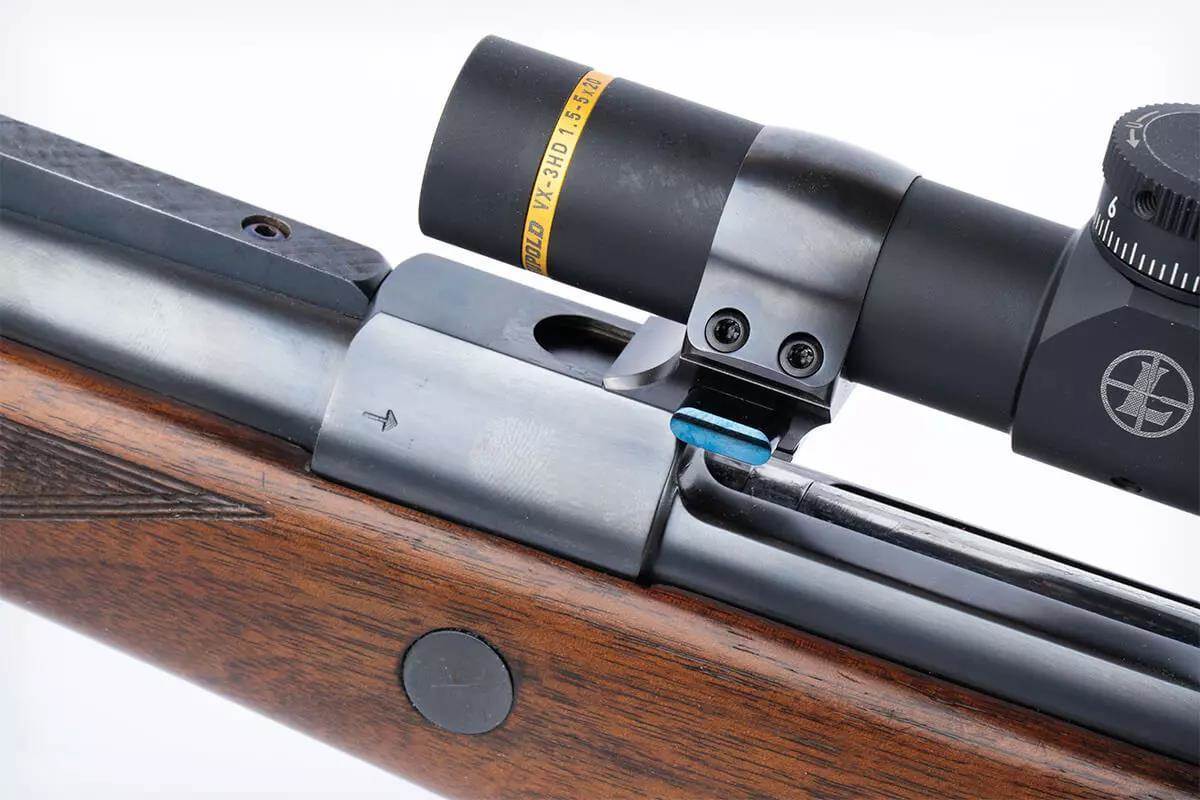
Reliability is now excellent, too, which is vital in a rifle I plan to use for hunting bears and hopefully Cape buffaloes. The trigger pull weight is 2 pounds, 15 ounces, enhancing this Mauser big bore’s shootability. Also, the buttstock has a 14.25-inch length of pull, which is perfect for my lanky build. The Dumoulin square-bridge Mauser 98 is configured to perfection for the tasks I intend to use it for. Its 20-inch barrel makes it lively and responsive and easy to carry day after day. The mild-but-potent 9.3×62 cartridge is adequate for dangerous game yet easy to shoot well by virtue of mangaeable recoil. With Smithson’s superb quick-detach scope-ring system, the fast-acquisition express-type iron sights, and the quick-install Smithson rear peep sight, my Dumoulin M98 Mauser is incredibly versatile. With the compact Leupold scope, I can reach out to 300 yards or more on plains game and elk. With the iron sights, I’m properly set up to blood-trail a bear into a thicket.
A century ago, I’d have written that the rifle is perfect for hunting lions in thornbrush, for Eurasian brown bears, and for shooting driven wild boars and red deer in the Black Forest. Times have changed, and I’ll never afford a lion hunt. However, I have plenty of adventures in mind for the lively Dumoulin dangerous-game rifle. I’ve dubbed it my “Little Big Gun,” a play on the old Dustin Hoffman classic film Little Big Man. It’s not a freight train of a big-bore stopping rifle, but it’s a whole lot more versatile. I’m as susceptible as the next guy to the mystique and lure of true big-bore bolt-action stopping rifles chambered in .416 Rigby, .458 Lott, and .505 Gibbs, but in the fervor for such rifles, a lot of very fine old medium-bore Mausers get overlooked. As a result, they’re a lot more affordable, and thanks to less costly ammo and milder recoil, I’ll wager you’d shoot one a lot more. So, if you’re in the market for a classy big-bore rifle, consider practical versatility and don’t overlook the milder Mausers.
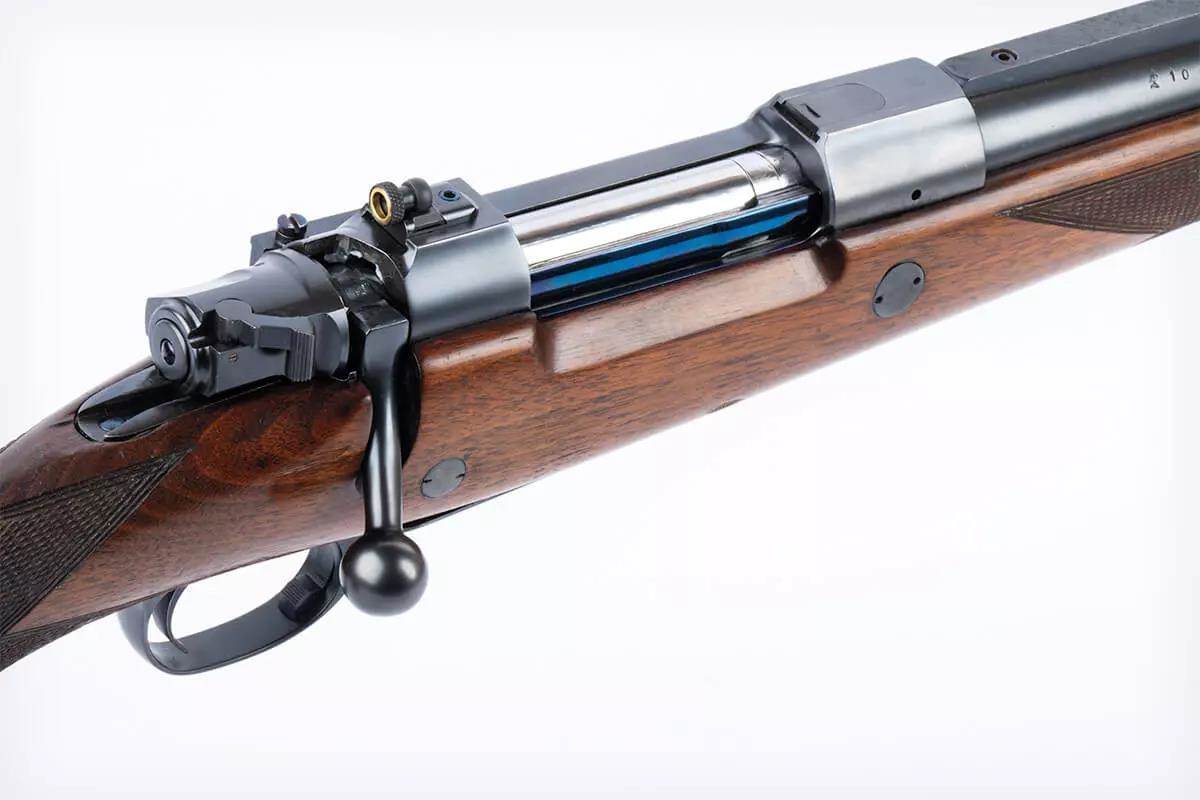
Custom Dumoulin Mauser 98 Specs
- Type: Bolt-action, repeater
- Caliber: 9.3×62
- Capacity: 4 rds.
- Barrel: 20 in.
- Overall Length: 41.5 in.
- Weight: 7.75 lbs.
- Stock: Walnut
- Length of Pull: 14.25 in.
- Finish: Rust blued barrel and action, oil finished wood
- Trigger: 2.9 lbs. (tested)
- Sights: Deep V express rear incorporated into quarter rib, removable aperture; bead on barrel-band ramp front with removable hood
- Safety: Three-position, wing type on bolt shroud
- Manufacturer: Dumoulin








